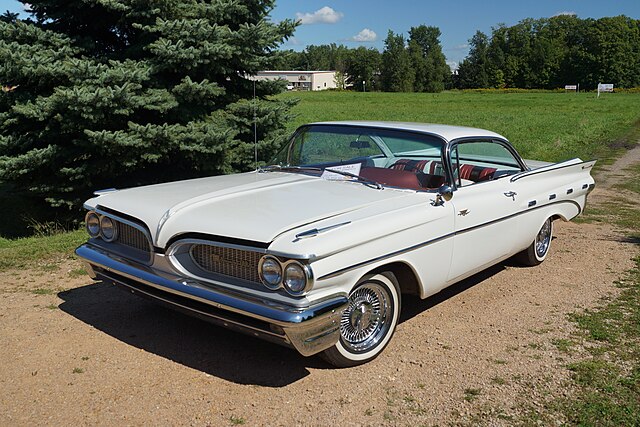
The Pontiac Bonneville, a staple in American automotive history, saw its second generation produced between 1959 and 1960. This period marked a significant evolution in design, performance, and cultural impact. The Bonneville was not just a car; it was a symbol of innovation and style during a transformative era for the American auto industry.
This article delves into the history, design, performance, and cultural significance of the 1959-1960 Pontiac Bonneville.
Historical Context

The Birth of the Bonneville
The Pontiac Bonneville was introduced in 1957 as a limited-edition performance convertible, and it quickly gained popularity. By 1959, it had evolved into its second generation, embodying the spirit of the late 1950s and early 1960s—an era characterized by economic prosperity and a burgeoning car culture in the United States.
The Automotive Industry in the Late 1950s
The late 1950s were a time of rapid innovation in the automotive industry. Car manufacturers were pushing the boundaries of design and engineering, aiming to capture the imagination of a growing market. The Pontiac Bonneville emerged during this golden age, showcasing cutting-edge features and styling that set it apart from its competitors.
Design and Styling
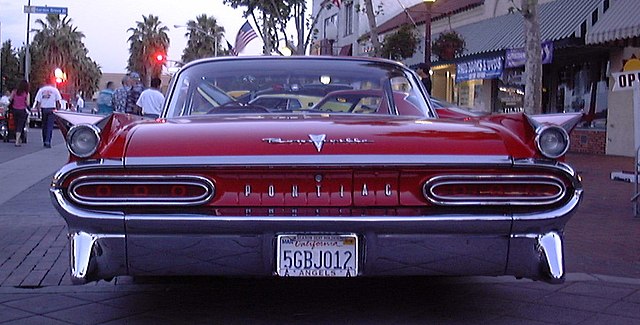
Exterior Design
The 1959-1960 Pontiac Bonneville was renowned for its sleek and stylish exterior. The car featured a longer, lower, and wider body than its predecessor, reflecting the era’s design trends. Key design elements included:
- Distinctive Front Grille: The wide, horizontal grille with dual headlamps on each side gave the Bonneville an imposing presence.
- Fins and Chrome: Prominent tailfins and generous use of chrome trim were hallmarks of the Bonneville’s design, contributing to its iconic look.
- Hardtop and Convertible Options: The Bonneville was available in both hardtop and convertible versions, catering to a wide range of customer preferences.
Interior Luxury
Inside, the Bonneville offered a luxurious and spacious cabin. The interior design emphasized comfort and elegance, featuring high-quality materials and advanced features for its time:
- Plush Seating: The seats were designed for maximum comfort, with options for leather upholstery.
- Instrument Panel: The stylish dashboard and instrument panel were designed for both functionality and aesthetics, incorporating futuristic design cues.
- Advanced Features: Innovations such as power windows, power seats, and an optional air conditioning system set the Bonneville apart from many of its contemporaries.
Performance and Engineering
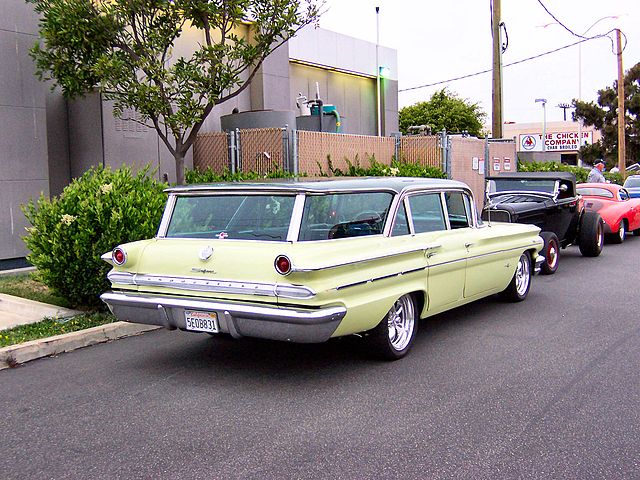
Engine Options
The 1959-1960 Bonneville was equipped with powerful V8 engines, delivering impressive performance that appealed to driving enthusiasts:
- 389 cu in (6.4 L) V8 Engine: The standard engine for the Bonneville was a 389 cubic inch V8, available in various configurations, including the high-output “Tri-Power” option, which featured three two-barrel carburetors for increased power.
Transmission and Handling
The Bonneville offered a range of transmission options to suit different driving styles:
- Hydra-Matic Transmission: The four-speed Hydra-Matic automatic transmission was popular for its smooth shifting and ease of use.
- Manual Transmission: A manual transmission was also available for those who preferred a more hands-on driving experience.
Suspension and Ride Quality
The second-generation Bonneville featured advanced suspension systems designed to provide a smooth and comfortable ride:
- Independent Front Suspension: The independent front suspension improved handling and ride comfort, making the Bonneville a pleasure to drive.
- Rear Suspension: The rear suspension was designed to handle the car’s weight and provide stability at high speeds.
Notable Features and Innovations
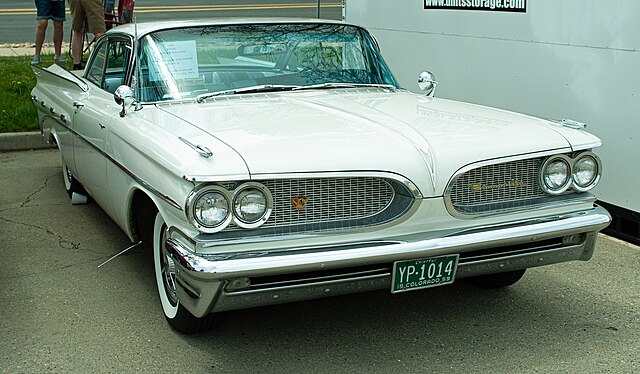
Safety Advancements
The 1959-1960 Pontiac Bonneville was not just about style and performance; it also incorporated several safety features that were innovative for its time. These advancements highlighted Pontiac’s commitment to driver and passenger safety, which was becoming an increasingly important aspect of automotive design.
Enhanced Braking System
The Bonneville featured a more robust braking system to handle its powerful V8 engines and the demands of its performance-oriented drivers. Key components included:
- Power Brakes: Available as an option, power brakes significantly reduced the effort required to bring the car to a stop, providing a safer and more comfortable driving experience.
- Improved Drum Brakes: The large drum brakes on all four wheels were designed to offer better stopping power and heat dissipation, crucial for maintaining performance during extended drives or in emergency situations.
Structural Integrity
The car’s body design included enhancements to improve structural integrity and passenger protection:
- Reinforced Frame: The Bonneville’s frame was reinforced to provide better crash protection and improve overall vehicle durability.
- Crumple Zones: Though rudimentary by modern standards, the design included early forms of crumple zones intended to absorb impact energy in the event of a collision.
Comfort and Convenience
Pontiac ensured that the Bonneville was at the forefront of automotive comfort and convenience, incorporating features that catered to the needs and desires of its discerning customers.
Climate Control
The Bonneville offered one of the most advanced climate control systems of its time:
- Air Conditioning: Available as an option, the integrated air conditioning system provided year-round comfort, allowing drivers and passengers to enjoy a pleasant interior environment regardless of external weather conditions.
- Efficient Heating: The heating system was designed to quickly warm the cabin, ensuring comfort during colder months.
Entertainment and Communication
Entertainment and communication features in the Bonneville were designed to enhance the driving experience:
- AM/FM Radio: The high-quality radio system provided excellent sound quality and a wide range of stations, making long drives more enjoyable.
- Push-Button Controls: The user-friendly push-button controls for the radio and other features highlighted the Bonneville’s blend of convenience and modern technology.
Technological Innovations
The Bonneville incorporated several technological innovations that set it apart from its competitors:
Fuel Management
Pontiac engineers focused on optimizing fuel efficiency without compromising performance:
- Tri-Power Carburetion: The Tri-Power setup with three two-barrel carburetors not only boosted horsepower but also improved fuel management by allowing for more precise control over fuel delivery.
Electrical Systems
Advanced electrical systems in the Bonneville enhanced both functionality and reliability:
- 12-Volt Electrical System: The transition to a 12-volt electrical system provided more reliable power for the car’s various electrical components, including the starter, lights, and accessories.
- Alternator: The Bonneville was one of the early adopters of the alternator, replacing the less efficient generator, which helped improve battery charging and electrical system reliability.
Cultural Impact and Legacy
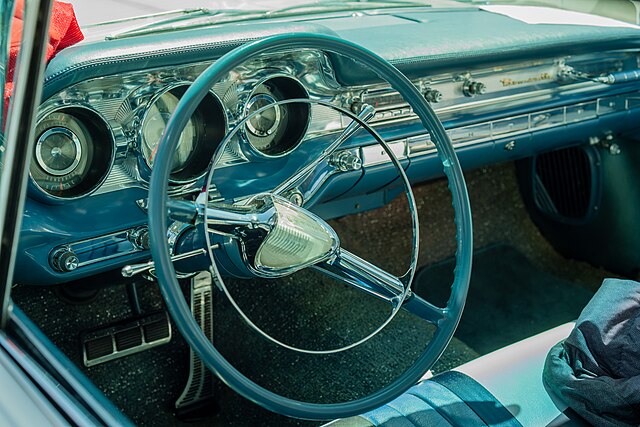
A Symbol of American Prosperity
The 1959-1960 Pontiac Bonneville epitomized the prosperity and optimism of post-war America. It was a car that symbolized success and status, often featured in advertising that highlighted its luxurious design and powerful performance.
Influence on Popular Culture
The Bonneville made frequent appearances in movies, television shows, and music, reinforcing its status as an American icon. It was often associated with the glamorous lifestyle of the time, making it a coveted vehicle among car enthusiasts and collectors.
Collectibility and Modern Day Appeal
Today, the 1959-1960 Pontiac Bonneville remains highly sought after by classic car collectors. Its unique design, historical significance, and powerful performance make it a prized possession. Car shows and auctions often feature the Bonneville, where it continues to garner admiration and high values.
Conclusion
The Pontiac Bonneville 2nd Generation (1959-1960) stands as a testament to the innovation and style of the late 1950s American automotive industry. With its striking design, luxurious features, and powerful performance, the Bonneville captured the spirit of its time and left an indelible mark on automotive history.
For classic car enthusiasts and collectors, the Bonneville remains a cherished symbol of a bygone era, representing the pinnacle of American automotive design and engineering.
In celebrating the Pontiac Bonneville, we not only appreciate a classic car but also recognize a cultural icon that encapsulated the dreams and aspirations of a generation. Its legacy endures, a reminder of the golden age of American cars and the timeless appeal of classic automotive craftsmanship.
